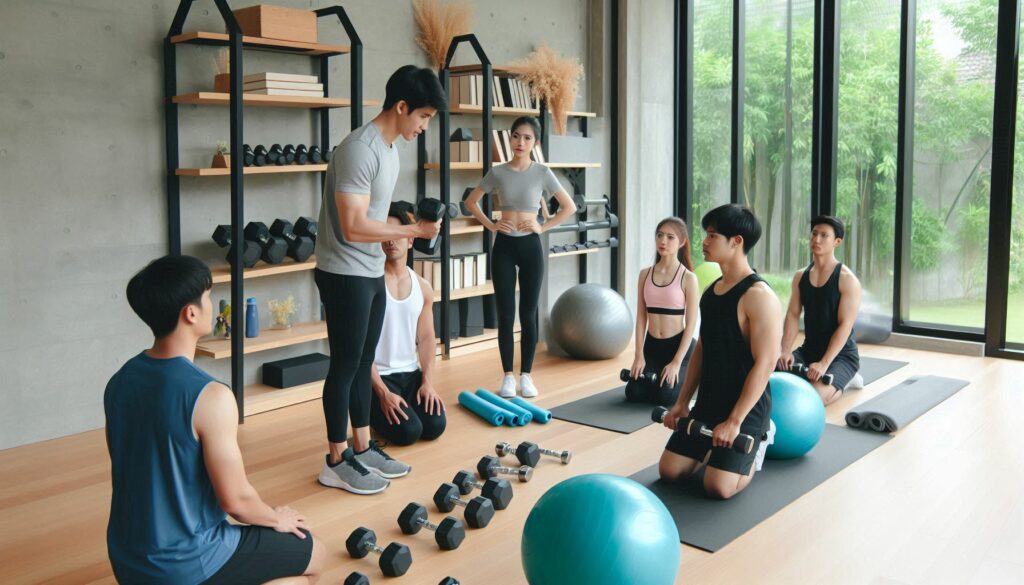The Ultimate Beginner’s Guide to Creating a Workout Plan for the Gym

Introduction
Embarking on a fitness journey at the gym can be exhilarating yet intimidating, especially for beginners. Crafting a solid workout plan is crucial as it lays down a clear path to achieve your fitness goals. This guide will walk you through the essential steps to design a beginner-friendly workout routine that’s both effective and enjoyable. The aim is to boost your confidence, increase your fitness levels, and set the foundation for a sustainable, healthy lifestyle.
Importance of a workout plan for beginners
Embarking on a fitness journey without a clear plan is like setting sail without a map, especially for beginners. A well-structured workout plan helps you stay on track and makes each gym session more effective. With a plan, you’ll be more likely to stick to your routine, maintain motivation, and see consistent progress.

A workout plan also ensures the right balance of exercises, avoiding the common pitfalls of overtraining or neglecting certain muscle groups. This strategic approach not only enhances your overall fitness but significantly reduces the risk of injury, making your gym time both enjoyable and rewarding.
Setting realistic fitness goals
When starting, it’s crucial to set achievable goals that fuel your motivation and give you a clear measure of progress. Begin with defining what you want to achieve, whether it’s weight loss, improved strength, enhanced endurance, or simply overall better health. Your goals should be SMART: Specific, Measurable, Achievable, Relevant, and Time-bound. An example of a realistic beginner goal might be, “I want to go to the gym three times per week and run for 20 minutes without stopping within three months.” This sort of goal is far more actionable and easier to commit to than vaguely “getting in shape.”
Designing Your Workout Plan
Choosing the right exercises for beginners
For beginners at the gym, the key is to start simple. Opt for exercises that build your core strength and stability while enhancing your balance and flexibility. Here’s a brief list of beginner-friendly exercises:

– Cardiovascular exercises like treadmill walking or stationary biking. These are great for warming up and improving heart health.
– Strength training basics such as squats, lunges, push-ups, and assisted pull-ups. These build the major muscle groups and provide a solid foundation for more complex movements.
– Simple free-weight exercises, like dumbbell curls and kettlebell swings, to introduce weightlifting fundamentals.
– Machine workouts, such as leg press and chest press machines, which help maintain correct form.
Remember, the technique is paramount; it’s better to perform exercises correctly with lighter weights than to risk injury with heavier ones. Consider asking a trainer for a demonstration or guidance.
Structuring your gym routine effectively
An effective gym routine for a beginner should include components of both cardiovascular and strength training, structured in a way that allows for gradual improvement. Here’s a general weekly layout that works well for beginners:
– Day 1: Focus on full-body strength training.
– Day 2: Cardio day; include activities like brisk walking or cycling.
– Day 3: Rest or gentle yoga for active recovery.
– Day 4: Target different muscle groups with varied strength exercises than on Day 1.
– Day 5: Another cardio day, possibly including interval training for variety.
– Day 6: Light activity or complete rest, depending on your energy and recovery needs.
– Day 7: Rest.
This rotation allows each muscle group adequate recovery time, while still keeping you active and committed to your plan.
Incorporating rest days into your plan
Rest days are crucial in any workout plan but are particularly important for beginners whose bodies are not yet accustomed to the stresses of regular exercise. Your muscles need time to repair and grow stronger, so incorporating ample rest days prevents overtraining, fatigue, and injuries. During rest days, focus on hydration, nourishing food, and perhaps some light stretching or walking to keep the body mobile without exerting stress on your muscles. This approach not only helps in physical recuperation but also mentally prepares you to tackle your next workout with greater energy and enthusiasm. Remember, fitness progress is as much about rest and recovery as it is about the workouts themselves.
Staying Motivated and Tracking Progress
Maintaining motivation and effectively tracking your progress are critical components to realizing your fitness goals. Progress can be an excellent motivator, but how exactly can you sustain it over time, especially when you’re just starting? Let’s explore some strategies to keep you moving forward and excited about your workout journey.
Creating a supportive environment
One of the most effective ways to stay motivated is by crafting a supportive social environment. This could mean joining a gym with a friend so you can encourage each other, attending group fitness classes, or even sharing your goals and progress on social media to garner support from your community. A supportive environment can empower you not only to attend the gym regularly but also to push yourself during exercises. Furthermore, positive reinforcement from others can significantly boost your spirits on days when your motivation is waning.
Utilizing fitness apps and tracking tools
In today’s digital age, numerous fitness apps and gadgets can help track your progress and keep you on track with your goals. Apps can log workouts, monitor your heart rate, count calories burned, and even provide virtual coaching. Fitness trackers and smartwatches can be constant reminders of your fitness journey, encouraging you to move more and stay active. By setting daily or weekly goals in these apps, you can also see tangible evidence of your improvements, which is incredibly motivating and rewarding.
Celebrating small victories along the way
Every step forward is worth celebrating when you’re new to the gym. Set small, achievable milestones, like increasing your workout frequency, adding weight to your lifts, or improving your endurance. Celebrate these achievements in ways that encourage further effort. Rewards could be a new workout outfit, a post-workout treat, or an extra hour of binge-watching your favorite show. Recognizing these small victories can provide a continuous supply of motivation and make the long-term journey enjoyable.
Fine-Tuning Your Workout Plan
As you progress in your fitness journey, you’ll need to fine-tune your workout plan to ensure it remains effective and aligned with your evolving goals. This involves seeking expert advice and listening to your body’s cues. Here’s how you can make those necessary adjustments.
Seeking guidance from fitness professionals
Even if you have a well-laid-out beginner’s plan, consulting with a fitness professional can provide immense benefits. Personal trainers can offer personalized advice tailored specifically to your physical condition and fitness goals.

They can also correct your form to prevent injuries and suggest modifications to increase the effectiveness of your exercises. If personal training sessions are beyond your budget, consider attending workshops or asking for quick tips during off-peak gym hours, as many trainers are more than willing to share their expertise.
Listening to your body and making necessary adjustments
The importance of listening to your body cannot be overstated. While it is essential to push yourself, recognizing the difference between pushing your limits and overtraining is crucial. If you feel overly fatigued, experience pain, or see your performance declining, these might be signs that you need to adjust your workout plan. This could mean integrating more rest days, altering your exercises, or even decreasing the intensity for a period. Adjustments aren’t setbacks; they’re an essential part of any sustainable fitness plan, ensuring long-term progress and preventing injuries.
Remember, the foundation of any successful fitness journey is built on consistent effort, adaptability, and self-care. Keep these pointers in mind as you embark on your path to becoming a healthier, stronger version of yourself.
Conclusion
Embarking on a new fitness journey can feel daunting, but having a solid workout plan as a beginner in the gym can set the foundation for success. Remember, the key is consistency and gradually increasing your challenge level. Start with the basics, listen to your body, and adjust as needed. Most importantly, enjoy the process of getting healthier and stronger. Your future self will thank you for the effort and time you invested today. Here’s to a healthier, more energetic you!






